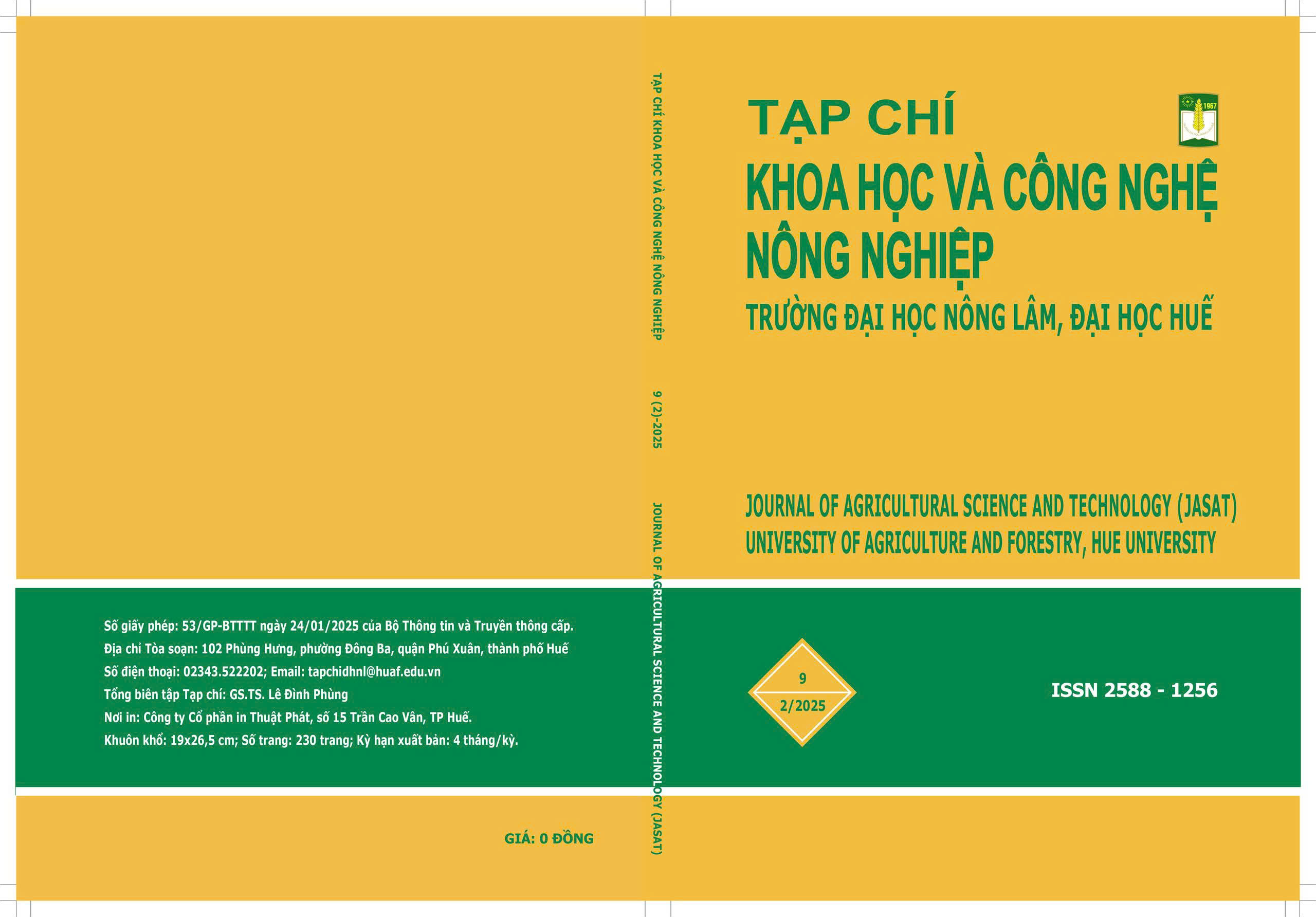##plugins.themes.huaf_theme.article.main##
Tóm tắt
Nghiên cứu khảo sát 102 nông hộ trồng mít tại Vĩnh Long nhằm đánh giá hiện trạng canh tác, nhận thức và thực hành quản lý cỏ dại. Kết quả cho thấy phần lớn nông dân có kinh nghiệm trồng mít dưới 5 năm (86,88%) và chủ yếu trồng các giống mít Thái (49,21%) và Ruột Đỏ (38,10%). Mô hình trồng hàng đôi với khoảng cách cây 2-3 m được áp dụng phổ biến (53,23%), giúp tối ưu diện tích nhưng đòi hỏi kỹ thuật chăm sóc cao. Có đến 48,39% nông dân xem cỏ dại là ít quan trọng, phản ánh sự thiếu nhận thức về tác hại của cỏ đối với năng suất và chất lượng mít. Tuy nhiên, cỏ cũng được một số hộ tận dụng vào cải tạo đất (48%), làm phân hữu cơ (47%) hoặc thức ăn chăn nuôi (3%). 20 loài cỏ phổ biến được ghi nhận, với các loài chiếm ưu thế là cỏ chác (Fimbristylis miliacea) (74,19%), rau trai (Commelina communis) (69,35%), Cỏ lá tre (Lophatherum gracile) (58,06%) và Cỏ đuôi phụng (Leptochloa chinensis) (33,87%). Các loài này có khả năng cạnh tranh dinh dưỡng, ánh sáng và là nơi cư trú của sâu bệnh, ảnh hưởng đến năng suất và chất lượng trái. Do đó, cần tăng cường truyền thông kỹ thuật và áp dụng chiến lược quản lý cỏ tổng hợp để phát triển bền vững vườn mít lâu năm.
##plugins.themes.huaf_theme.article.details##
Tài liệu tham khảo
Khổng Tiến Dũng. (2022). Nghiên cứu giải pháp phát triển chuỗi giá trị mít tại tỉnh Hậu Giang. Hue University Journal of Science: Economics and Development, 131(5C), 83-101.
Nguyễn Kim Quyên, Trần Văn Hùng, Ngô Phương Ngọc, Trần Hoàng Em, Ngô Ngọc Hưng, và Lê Văn Dang. (2024). Ảnh hưởng của tuổi liếp đến sự thay đổi một số tính chất độ phì nhiêu của đất trồng sầu riêng ở đồng bằng sông Cửu Long. Tạp chí Nông nghiệp và Phát triển nông thôn, 493(2), 34–42.
Ủy ban nhân dân tỉnh Vĩnh Long. (2023). Quyết định: Về việc ban hành kế hoạch sản xuất cây trồng chủ lực và tiềm năng đến năm 2030 trên địa bàn tỉnh Vĩnh Long. https://thuvienphapluat.vn/van-ban/Linh-vuc-khac/Quyet-dinh-1607-QD-UBND-2023-Ke-hoach-san-xuat-cay-trong-chu-luc-den-2030-Vinh-Long-573285.aspx
2. Tài liệu tiếng nước ngoài
Bhatt, M. D., & Singh, S. P. (2007). Soil seed bank dynamics of weed flora in upland and lowland paddy cultivation areas of far western Nepal. Scientific World, 5(5), 54-59.
Chauhan, B. S., & Johnson, D. E. (2011). Ecological studies on Echinochloa crus-galli and the implications for weed management in direct-seeded rice. Crop Protection, 30(11), 1385-1391.
Ekwealor, K. U., Echereme, C. B., Ofobeze, T. N., & Okereke, C. N. (2019). Economic importance of weeds: A review. Asian Plant Research Journal, 3(2), 1-11.
Granatstein, D., Wiman, M., Kirby, E., & Mullinix, K. (2008). Sustainability trade-offs in organic orchard floor management. In: Organic Fruit Conference 873 (pp. 115-122).
Justus, A. R., & Justus, E. R. (2024). Feasibility analysis of multi-cropping Jackfruit trees with rubber plantation: An Indian perspective. Journal of Tropical Agriculture, 62(2), 145-157.
Laishram, M., & Ghosh, S. N. (2017). Effect of intercropping on plant and soil of jackfruit grown in new alluvial soil of West Bengal. Journal of Crop and Weed, 13(1), 55-59.
Licznar-Malanczuk, Maria & Kwiecińska, Iwona. (2016). The weed composition in an orchard as a result of long-term foliar herbicide application. Acta Agrobotanica. 69. DOI: 10.5586/aa.1685.
Lisek, J., & Sas-Paszt, L. (2015). Biodiversity of weed communities in organic and conventional orchards. Journal of horticultural research, 23(1), 39-48.
Mia, M. D., Massetani, F., Murri, G., & Neri, D. (2020). Sustainable alternatives to chemicals for weed control in the orchard-a Review. Horticultural Science, 47(1), 1-12.
Miah, M. G., Islam, M. M., Rahman, M. A., Ahamed, T., Islam, M. R., & Jose, S. (2018). Transformation of jackfruit (Artocarpus heterophyllus Lam.) orchard into multistory agroforestry increases system productivity. Agroforestry Systems, 92, 1687-1697.
Monteiro, A., & Santos, S. (2022). Sustainable approach to weed management: The role of precision weed management. Agronomy, 12(1), 118.
Narayanasamy, N. (2008). Participatory rural appraisal: Principles, methods and application. Delhi; SAGE Publications Ltd. Print.
Nguyen, C. K., Tran, H. Q., Nguyen, T. Y. N., Bach, L. G., & Tran, T. T. (2025). A comparison of the morphological characteristics, physiochemical, nutrients, and antioxidative activities of four genotypes of jackfruits (Artocarpus heterophyllus) located in Mekong Delta, Vietnam. Applied Food Research, 5(1), 100847.
Pupalienė, R., Sinkevičienė, A., Jodaugienė, D., & Bajorienė, K. (2015). Weed control by organic mulch in organic farming system. InTech. DOI: 10.5772/60120.
Sammut‐Bonnici, T., & Galea, D. (2015). SWOT analysis. Wiley Encyclopedia of management, 1-8.
Schaedler, C. E., Noldin, J. A., Agostinetto, D., Dal Magro, T., & Fontana, L. C. (2013). Germination and growth of Fimbristylis miliacea biotypes resistant and susceptible to acetolactate synthase-inhibiting herbicides. Planta Daninha, 31(3), 687-694.
Takano, H. K., & Dayan, F. E. (2020). Glufosinate‐ammonium: a review of the current state of knowledge. Pest Management Science, 76(12), 3911-3925.
USDA. (2024). FoodData Central: Jackfruit, raw. U.S. Department of Agriculture. Retrieved from https://fdc.nal.usda.gov
Minh, Vo & Thuong, Trinh & Thuy, Nguyen & Giau, Tran Ngoc & Van Hao, Hong & Ngo, Tai. (2024). Current status of post-harvest of jackfruit - potential for use and circular economy in Vietnam. International Journal of Chemical and Biochemical Sciences, 26. 10.62877/3-IJCBS-24-26-20-3.
Woyessa, D. (2022). Weed control methods used in agriculture. American Journal of Life Science and Innovation, 1(1), 19-26.


